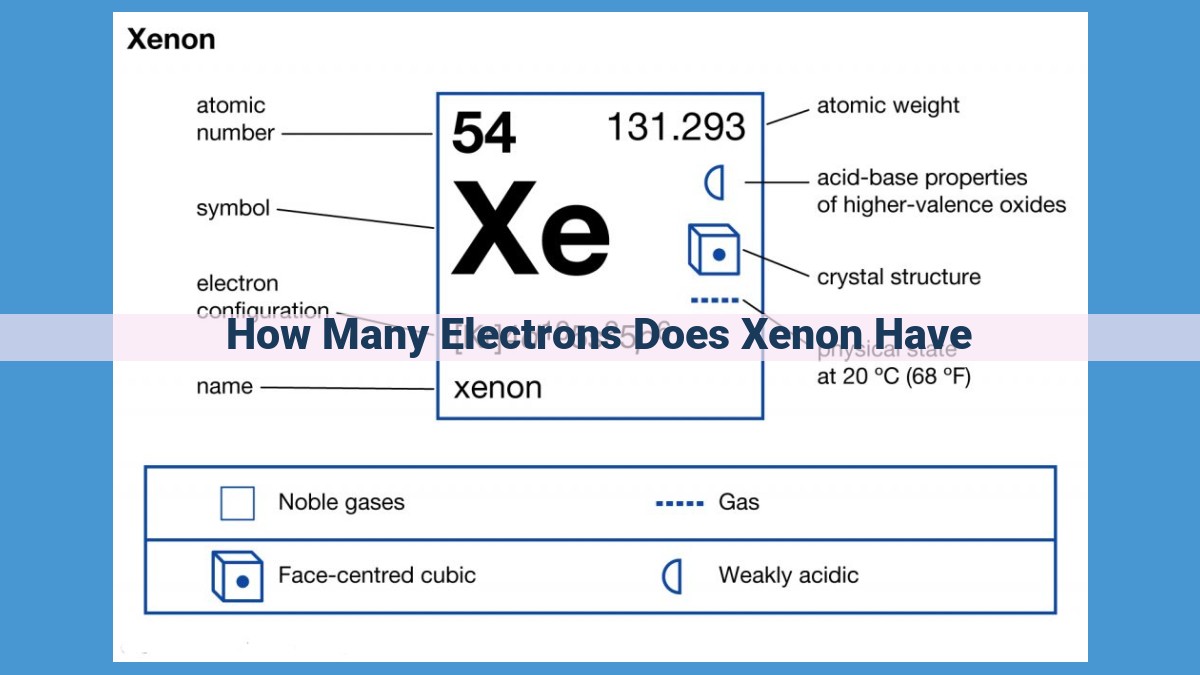Xenon, a noble gas in Group 18 of the periodic table, possesses a closed-shell electron configuration, [Xe] 5s²5p⁶, resulting in a total of 54 electrons. Its stable electron configuration grants it a high ionization energy and low electron affinity, contributing to its inert nature. Xenon exhibits a range of oxidation states, including +2, +4, +6, and +8, and has stable isotopes such as ¹²⁹Xe and ¹³¹Xe.
Unveiling the Enigmatic Xenon: A Journey into Its Electron Configuration and Valence Electrons
In the vast expanse of the periodic table, where elements dance in a rhythmic array, xenon stands as a enigmatic noble gas, cloaked in an aura of mystery and intrigue. Its exceptional properties have sparked scientific curiosity and paved the way for groundbreaking discoveries.
Xenon’s Noble Stature
Xenon resides in the esteemed company of noble gases, occupying Group 18 in the periodic table. This aristocratic group is characterized by a remarkable stability, boasting a complete outer electron shell. Xenon’s electron configuration of [Xe] 5s² 5p⁶ reflects this stability, with eight electrons filling its outer energy level.
Valence Electrons: The Key to Reactivity
The concept of valence electrons, those electrons residing in the outermost energy level, plays a pivotal role in determining an element’s chemical reactivity. For xenon, the presence of eight valence electrons renders it chemically inert. This inertness stems from the fact that xenon’s valence shell is completely filled, making it reluctant to engage in chemical reactions.
Ionization Energy and Electron Affinity
Every atom has a unique set of properties, and xenon is no exception. Ionization energy measures the energy required to remove an electron from an atom, while electron affinity measures the energy released when an electron is added to an atom. These properties are influenced not only by xenon’s specific electron configuration but also by its position in the periodic table.
Xenon’s stable electron configuration is a key factor influencing its ionization energy. The noble gases, including xenon, have a full complement of electrons in their outermost shell, making them highly stable. Removing an electron from such a stable arrangement requires significant energy, resulting in xenon having a high ionization energy.
In contrast, xenon’s electron affinity is relatively low. This means that adding an electron to xenon releases only a small amount of energy. The stable electron configuration of xenon makes it less eager to accept an additional electron, resulting in its low electron affinity.
Oxidation States and Isotopes of Xenon
Oxidation States
Xenon exhibits various oxidation states in its compounds due to its ability to form bonds with other elements. Common oxidation states include:
- +2 (e.g., XeF2)
- +4 (e.g., XeO2)
- +6 (e.g., XeO3)
- +8 (e.g., XeO4)
The +2 oxidation state is the most stable for xenon, as it achieves a stable octet of valence electrons by forming two covalent bonds.
Isotopes
Xenon has nine stable isotopes, with Xenon-136 being the most abundant (84.6% natural abundance). The remaining stable isotopes are:
- Xenon-124
- Xenon-126
- Xenon-128
- Xenon-129
- Xenon-130
- Xenon-131
- Xenon-132
- Xenon-134
These isotopes vary in their neutron count, affecting their atomic mass and stability. Isotopes of the same element have identical chemical properties, but they may differ in physical properties such as mass and radioactivity.
Atomic Structure and Periodic Trends
- State xenon’s atomic number and explain its significance.
- Explain xenon’s position in the periodic table and its relationship with other noble gases.
- Describe how xenon’s properties align with the periodic trends observed in the periodic table.
Atomic Structure and Periodic Trends
Xenon, an inert gas, resides in the periodic table’s Group 18, also known as the noble gases. It holds the atomic number 54, signifying the number of protons in its nucleus. This unique atomic structure plays a crucial role in defining xenon’s properties.
As a noble gas, xenon shares a common characteristic with its group members: a stable electron configuration known as an octet. Its electron configuration, represented as 1s²2s²2p⁶3s²3p⁶3d¹⁰4s²4p⁶, reveals that xenon possesses a full outermost electron shell. This stable configuration grants xenon a low tendency to react with other elements.
Within the periodic table, xenon’s position follows a predictable pattern. Moving down the group, from helium to radon, the atomic number increases by eight for each successive element. This periodic trend results in an increase in atomic size, as more energy levels are added. Consequently, xenon has a larger atomic radius compared to other noble gases.
Moreover, xenon’s properties align with the periodic trends observed across the periodic table. Its ionization energy, which represents the energy required to remove an electron from an atom, is relatively high. This is due to xenon’s stable electron configuration, which makes it difficult to remove an electron. In contrast, xenon’s electron affinity, or the energy released when an electron is added to an atom, is low. This indicates that xenon has a weak attraction for additional electrons.
